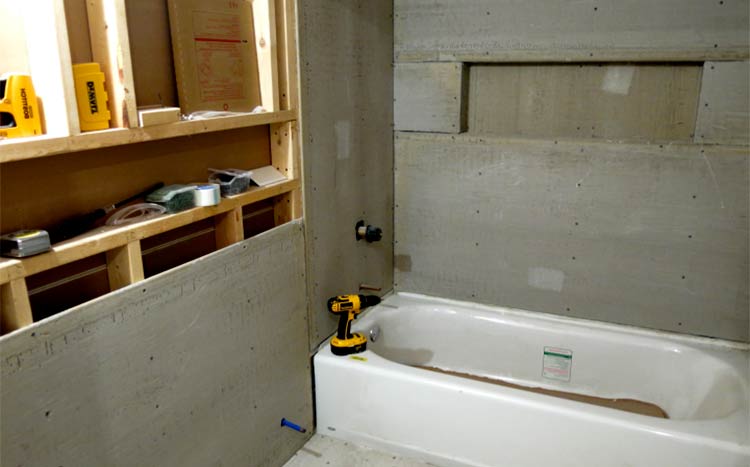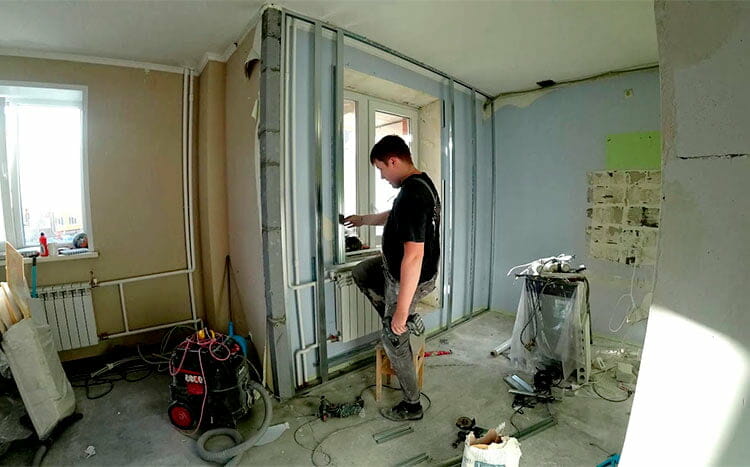Drywall, made of gypsum and paper, offers an economical way to swiftly encase framed walls.
You can not use regular drywall in the bathroom. Moisture-resistant drywall must be used for high humidity areas. Greenboard drywall is the most common solution.
Greenboard drywall is not appropriate for areas that experience a great amount of water such as showers and tub surrounds. For these areas, you should use cement, glass fiber, or fiber cement boards.

Difference between regular and greenboard drywall?
The difference between regular drywall and greenboard is in the core. While the core of the regular drywall is made from pressed gypsum, the greenboard core is treated with silicone additives to repel moisture. It handles in the same way as regular drywall, and you hang and finish it in the same way. Another important thing to know is that you have to be sure that the screws or nails you use are corrosion resistant or stainless because if they are not over time they will completely disintegrate in the wall and they will cause cracks.
Wet walls covering
Even it repels moisture, greenboard drywall is not the best option for walls that get wet, such as those in shower stalls or tub surrounds. Cement, glass fiber, or fiber cement boards had to be your choice for those areas. They aren’t completely waterproof, but still, they won’t lose their shape and separate from the wall if a leak develops. Typically they are heavier than greenboard and harder to work with but you will get better results eventually.
Greenboard drywall uses and locations
As we mentioned above greenboard drywall is not acceptable to use everywhere. Below is the list of which locations are acceptable and which are not:
Acceptable locations:
- Bathtub enclosure, pre-fabricated
- Basement areas other than bathing facilities
- Kitchen, near the sink
- All other dry or damp areas
Not acceptable locations:
- Shower stalls
- Tiled bathtub enclosures
- Water-prone basement walls
- Saunas
- Steam rooms
Greenboard drywall VS cement board
The cement board is perfect for tile-covered wet applications like showers and tub surrounds. Wet or dry, such a backer board provides a stable base for tiling.
The main reason why drywall may experience mold and mildew is the organic element in drywall’s paper. Because of this, you may consider using greenboard drywall with fiberglass coating instead of paper. It provides better protection because it has higher mold and moisture resistance.
While cement board can be used as a base for tile flooring, drywall of any type can never be used for flooring application. Builders use greenboard for highly wet areas because is cheaper than cement board and easier and faster to install.
Greenboard drywall in highly wet locations is possible but not recommended, cementitious products are a better choice for that areas. Severe mold growth will definitely occur with drywall when the drywall has been subjected to an abundance of water.
Moisture and mold resistant drywall (purple)
It is good to mention that out there is another type of drywall that will give you extra protection against moisture and potential mold growth, “purple” drywall. This drywall prevents moisture absorption just like the greenboard, but it also inhibits mold growth. The texture of the purple drywall is not always smooth as the standard and greenboard drywall, making it more difficult to finish.

Use this FREE service
HomeGardenGuides.com is a free service that quickly matches you with top-voted local Drywall Specialists.
You can get 3 estimates fast by real certified experts in your area in just 2 minutes.
- Scroll to the top of the page and enter your Zip code.
- Answer questions about your drywall job
- Your drywall task details are forwarded to three local experts. They will send you a price estimate for the job and some friendly advice.
IMPORTANT: There is no obligation to hire. This is a free tool and service to be used at your pleasure.
Different types of drywall cost
This is not an article that presents how much does drywall costs, but I think that is good to have a quick look at the prices. Below is a table where you can see the prices of different types of drywall including moisture and mold resistance:
| Type | Cost per sheet (Material only) |
|---|---|
| Traditional/Standard/Regular | $10 - $12 |
| Plaster Blue Board | $11 - $14 |
| Fire-Rated (Type X) | $12 - $21 |
| Moisture-Resistant (green) | $13 - $15 |
| Moisture and Mold Resistant (purple) | $13 - $15 |
| Eco-Friendly | $14 - $20 |
| Paperless | $15 - $22 |
| Soundproof | $50 - $70 |
As you can see from the table, moisture, and mold-resistant types of drywall are around 30% more expensive than regular drywall.
The best thickness of drywall for bathroom
Many bathrooms are small enough that the advantages of thicker drywall, ⅝“ for example, aren’t seen. The most important thing for the bathroom is to use moisture and mold-resistant drywall. These types of drywall are easy to obtain in ½” thickness.
If you are installing tile I would suggest you use one of the tile backer boards designed for tile installation instead of thicker drywall.
FAQ's
Use Liquid Nails to glue the walls above the shower, then use clear, waterproof caulking on top, inner corners, and bottom where it meets the top of the shower.
Yes, you can use regular drywall in ceilings above the non-shower or tub areas of your bathroom. However, for the space where the shower is located, it is recommended to pick moisture-resistant and mold-resistant drywall.
In the case of flooding no, but in rooms that experience frequent humidity and are often subject to mold and mildew, such as bathrooms and basements, mold-resistant drywall is a good choice.
Mold-resistant drywall outer paper covering resists water but it is not considered to be waterproof.







